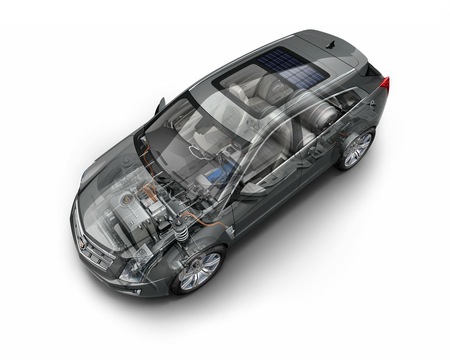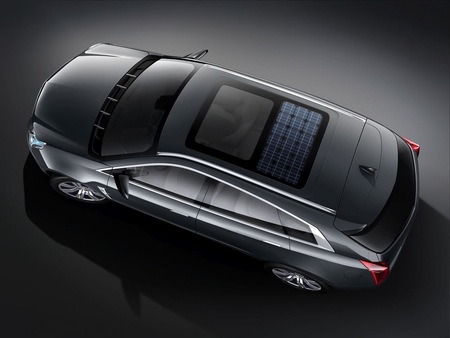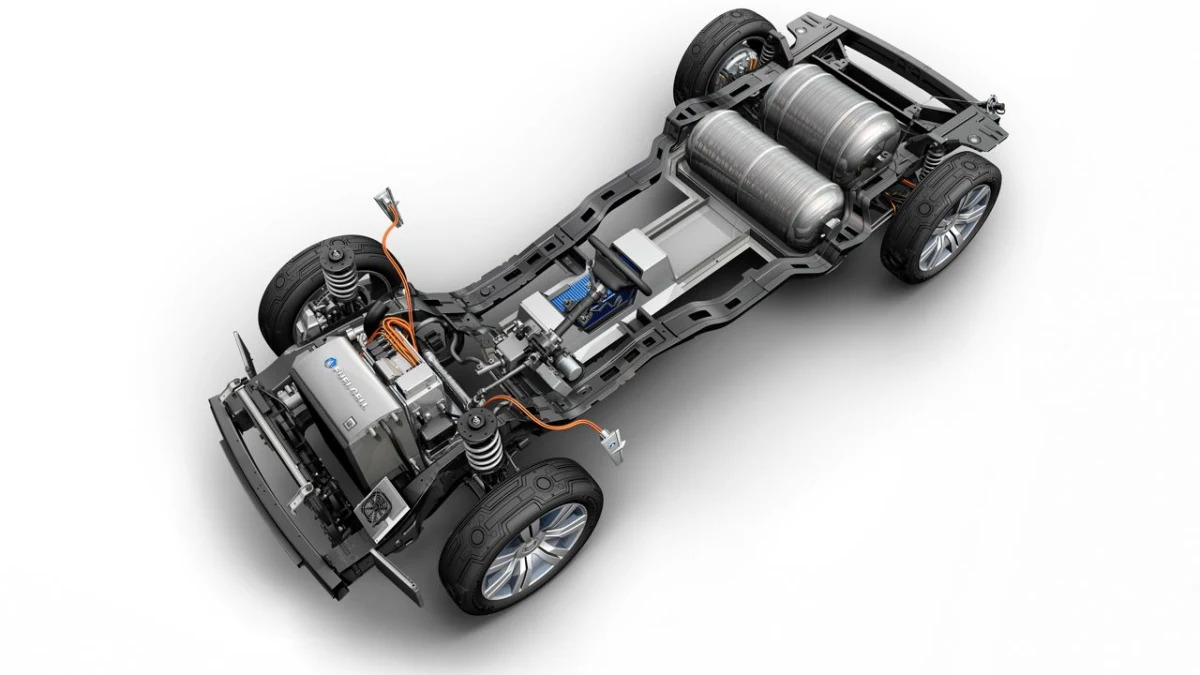Click the Cadillac Provoq for a high-res gallery
Almost a year to the day after we first showed you the Chevrolet Volt, General Motors is unveiling the third body style (the second was the Opel Flextreme) based on the E-Flex platform that forms the basis of the Volt. This time around they are moving the architecture to a more up-market vehicle. The Cadillac Provoq concept is a luxury mid-size crossover built on a variant of the fuel cell drive-train that GM first showed in the Volt at the 2007 Shanghai Motor Show.
A few months ago some stories started circulating that Volt would get badged as a Cadillac instead of a Chevrolet so that they could justify a higher price to cover the high cost of the battery pack. Subsequently, the story evolved so that the fuel cell powered E-Flex variant would be the vehicle with a Caddie badge. Based on what we saw at the E-Flex design studio a couple of weeks ago and this new concept, it now appears that this latter story may turn out to be reality. Read on after the jump to find out all about the Cadillac Provoq advanced technology concept.
[Source: General Motors]
Back in October when we reported on the rumor of a Cadillac fuel-cell E-Flex vehicle, GM spokesman Rob Peterson told us that the story was pure speculation. However it now appears that someone familiar with this new concept probably leaked the information. With the previously announced Escalade Two-Mode hybrid and the new Provoq, Cadillac wants to start promoting the idea of premium sustainability. The layout of the Provoq power-train is almost exactly the same as the fuel cell Volt that Chevrolet showed in Shanghai last April but it differs in the details.

Like both previous versions of the Volt, the Provoq is purely electrically driven and has plug-in capability. Also like the fuel cell version of the Volt, this one is built around GM's latest fifth-generation fuel cell stack. We wrote in detail about the new stack design last summer and you can read about it here. In short this stack is the first one that GM has designed with the goal of mass production. The previous designs were all experimental prototypes for research purposes. That means the components were hand built and assembled at great cost. The new design integrates many of the ancillary systems and incorporates much of the plumbing for the air, hydrogen and water drainage into a cast case.
The Provoq is a crossover wagon and is considerably larger than the Volt with an overall length of 180.3", 67" height and 72.8" width. The Volt concept, by comparison, measures 170" x 52.6" x 70.5". The Provoq rides on a 114.4" wheelbase making it almost exactly the same size as a Saturn Vue. To keep the performance and range up on the larger, premium Cadillac, most of the power-train has been up-sized from the Volt. The fuel cell stack has been bumped from 80 to 88kW while the two rear hub motors have gone from 25 to 40kW units. The front drive unit remains a 70kW AC motor. That extra power is enough to move the Provoq from 0-60 mph in 8.5 seconds, a thirty percent improvement over the current fuel cell Equinox. The brakes are fully electrically actuated and provide blending of friction and regenerative braking.
The lithium ion battery pack still sits down the center console between the front seats but has grown from 8 to 9kWh capacity. Hydrogen gas for the fuel cell is compressed at 10,000 psi and stored in a pair of tanks mounted beneath and behind the rear seat. The total hydrogen capacity has been increased from 4kg to 6kg. In total the energy storage system provides a 20 mile plug-in range from the battery pack complementing the 280 miles of hydrogen range for a total of 300 miles.
The video meant to be presented here is no longer available. Sorry for the inconvenience.
The Cadillac design team, led by Clay Dean and exterior design lead Hoon Kim, have created a modern CUV design that incorporates the latest Cadillac design language. They have also incorporated the lessons learned by Bob Boniface and the Volt design team in the area of aerodynamics. The Volt concept design was completed and built in a short time frame and there was little focus on drag reduction. Not so with the Provoq. Being aware of the influence of drag on range, even at city driving speeds, caused the Provoq team to incorporate some innovative features.
A look at the front end of most fuel cell powered vehicles (see the Chevy Sequel or fuel cell Equinox) reveals some pretty enormous air intakes. Fuel cells can generate a lot of heat that needs to be dissipated. Unfortunately those large openings create a lot of drag. To get around this, the Provoq has a large grille in the fashion of other current Cadillacs like the new CTS and STS. Behind the grille are a series of thermostatically controlled slats that control the airflow. When the stack heat needs to be dissipated, the slats open up allowing cooling air to flow. When the vehicle is running off the battery or the loads on the stack are low, the slats close up forcing air to flow around the nose of the vehicle.

Drag is further reduced through he use of a full under-body belly pan. Along the sides, door handles are mounted flush with the body sides. To open the door, you press on the handle and it pops out. On the inside the Provoq gets a roomy open design for a feeling of spaciousness. Providing climate control for a large interior can draw quite a bit of energy cutting seriously into the range. To help mitigate this problem, the Provoq has a panel of photo-voltaic cells incorporated into the roof. The cells can't really provide enough power to be useful for charging the battery pack. What the solar power can do is run the climate control system while the vehicle is parked, providing heating or cooling as needed to regulate the internal temperature without drawing from the battery. Pre-heating or cooling can dramatically reduce the load on the fuel cell and battery when you get in to drive.
All of this adds up to defining Cadillac as a technology leader. Even with the reduced manufacturing cost of the fifth-gen stack, the limited availability of hydrogen filling stations will necessarily keep volumes for fuel cell vehicle down for the foreseeable future. That means the cost of such vehicles will remain high. Another factor to consider is that Cadillac sells reasonably well in China, where a hydrogen infrastructure is expected to develop faster than in the U.S. Since GM has committed to developing the internal combustion and fuel cell E-flex derivatives in parallel, it makes sense to apply the fuel cell variant to a Cadillac which could sell in China and elsewhere. The Volt will be the mass market vehicle but if it's successful a vehicle based on this new concept may well follow it to market in the next few years.
CADILLAC PROVOQ FUEL CELL CONCEPT DELIVERS CLEAN, PETROLEUM-FREE PERFORMANCE AND SIGNATURE DESIGN
LAS VEGAS – Cadillac unveils a new vision for the future of luxury transportation with the innovative Provoq fuel cell concept – a hydrogen fuel cell crossover vehicle that continues GM's commitment to displace petroleum through advanced technology.
The Cadillac Provoq fuel cell concept is the latest example of GM's groundbreaking E-Flex propulsion system, combining the new fifth-generation fuel cell system and a lithium-ion battery to produce an electrically driven vehicle that uses no petroleum and has no emission other than water. The concept's fifth-generation fuel cell technology is half the size of its predecessor, yet it has been developed to produce more power and performance.
"Cadillac is a natural fit for GM's next step in developing the E-Flex platform," says Jim Taylor, Cadillac general manager. "Cadillac, at its very essence, is about premium luxury, design and technology, so it's fitting that Cadillac would be propelled by the most elegant solution. This signals Cadillac's intent to lead the industry with alternative-fuel technology."
Fuel-cell variant of the E-Flex system
The concept can drive 300 miles (483 km) on a single fill of hydrogen – with 280 miles (450 km) from hydrogen and 20 miles (32 km) on pure, battery electric energy.
A pair of 10,000 psi (700 bar) composite storage tanks beneath the rear cargo floor hold 13.2 pounds (6 kg) of hydrogen to feed the fuel cell stack, located under the hood. There, hydrogen mixes with oxygen to generate electricity – up to 88 kW continuous power. A lithium-ion battery pack can store up to a total of 9kWh of electrical energy and also provides a peak of 60 kW of power for additional performance.
The electricity generated by the fuel cell is distributed to a 70 kW co-axial drive system for the front wheels and individual, 40 kW wheel hub motors on the rear wheels, giving the Cadillac Provoq its all-wheel-drive traction and great driving dynamics. Its 0-60 mph (approximately 100 km/h) speed of 8.5 seconds is a more than 30-percent improvement over the previous-generation fuel cell system and with instantaneous torque to the wheels, it feels even faster. Provoq has a top speed of 100 mph (160 km/h).
"This is a vision of what comes next – a fuel cell electric vehicle that delivers the driving characteristics Cadillac customers want and allowing them to do it without using a single drop of petroleum, while emitting only water vapor," said Larry Burns, GM vice president for research and development. "This is proof that alternate fuels and advanced technologies create even greater opportunities to satisfy the luxury buyer."
Key features
With sleek, signature Cadillac bodywork, the Provoq concept redefines luxury crossovers, offering uncompromising passenger and cargo space to match its performance and cruising range. Additional vehicle features include:
Solar panel integrated in the roof to help power onboard accessories, such as the interior lights, audio system and more
Brake-by-wire technology
Front grille louvers that close at highway speed to enhance aerodynamics, and open at low speed to provide maximum cooling to the fuel cell stack
Purposefully dynamic design
The Provoq has a sleek, athletic shape that builds on the second generation of Cadillac's design renaissance, led by the 2008 CTS, with dynamic and purposeful features that support the hydrogen fuel cell powertrain and contribute to the vehicle's overall efficiency.
"All the people- and cargo-carrying capability customers expect in crossovers and SUVs is available in the Provoq, along with the premium attributes expected in a Cadillac," said Ed Welburn, vice president, Global Design.
Highlights include:
Active front grille, with grille louvers that open when the fuel cell stack requires cooling
Full underbody aerodynamic cover
Left- and right-hand charging ports incorporated in stylish front fender vents
Flush door handles that feature push-to-release operation
Wind tunnel-shaped outside mirrors with integral turn signals
Center high-mounted rear stop lamp incorporated into full-width, wraparound spoiler
Signature vertical taillamps with subtle fin design
Side glass mounted flush with pillars
Wheels with clear-covered space between the spokes, creating a sleeker profile while maintaining Cadillac's signature bold wheel design
Low-drag roof rack
"From the strong, shield grille and vertical headlamps to the crisp body lines, the Provoq is instantly recognizable as a contemporary Cadillac," said Hoon Kim, exterior lead designer. "Like the new CTS, it is bold and expressive, but there is enhanced shape between the edges – it's a new proportion for crossovers, with a fast, almost coupe-like rear.
"Everything about the vehicle reinforces the notion that great style and environmentally conscious transportation can go hand in hand," said Kim. "We didn't sacrifice proportion, stance or Cadillac's iconic design cues; we used them to support the efficiency of the vehicle.
"They are the features customers expect," he said. "The adaptability of the E-Flex architecture enabled the designers to create a great-looking vehicle, regardless of its alternative-fuel powertrain."
Kim points to the fender-mounted charge ports as prime example. They allow overnight, plug-in charging that extends the driving range. The ports have a satin-chrome appearance that incorporates an amber light to indicate the system is charging and a green light to indicate when charging is completed.
"The ports are functional, but rather than hide them, they are design elements of the Provoq," he said. "Sweeping body lines that culminate at the top and bottom edges of the ports suggest forward thrust, even when the vehicle is stationary."
The vertical, neon-lit taillamps blend style with functionality, too, as their finned shape was designed to make the Provoq as aerodynamically efficient as possible.
Indeed, the Provoq has short overhangs and a sporty ride height that is complemented by large, 21-inch wheels.
The wheels are wrapped in custom Michelin tires incorporating Green-X technology. These low-rolling resistance tires feature a tread pattern that mimics the "H20" notation for water.
The tire designers and engineers at Michelin North America enthusiastically accepted GM's challenge to create a custom low-rolling resistance tire to complement the energy efficiency and reduced environmental footprint of the Cadillac Provoq. During the past 15 years, the tire maker has developed four generations of Michelin green energy-saving tires, and the team's no-compromises approach to the project helped reduce the Provoq's overall fuel consumption without sacrificing road performance, grip and safety.
When used in conjunction with the other energy-efficient solutions featured on the Cadillac Provoq, the benefits of Michelin green energy-saving tires include:
A reduction in the consumer's overall cost of ownership
An extended vehicle range through a more efficient use of on-board energy and its storage capacity
A reduction of vehicle impact on the environment through lower CO2 and particulate emissions.
Uncompromising interior
Like the exterior, the Provoq's interior blends style with function. It seats five and incorporates the comfort, convenience and infotainment features Cadillac customers seek. Most importantly, the fuel cell powertrain does not intrude on passenger or cargo room.
The hydrogen fuel tanks are mounted beneath the cargo floor, with the storage batteries located at the center of the chassis. The fuel cell stack is located under the hood, giving the Provoq the interior layout of a conventional crossover – including a full cargo area and a 60/40-split folding rear seat.
"The interior is roomy, well-equipped and offers the space people want in a crossover," said Matt Erdey, interior lead designer. "There are no compromises inside the Provoq to accommodate the fuel cell powertrain and fuel tanks – a factor that proves the technology and real-world feasibility are growing closer together."
There may not be compromising reminders of the powertrain in the interior, but the Provoq carries the instantly identifiable hallmarks of a contemporary Cadillac interior, with an expressive, well-crafted design.
"It picks up the cues, refinement and attention to detail of the new CTS and takes them to the next level," said Erdey. "A contrasting color scheme, extensive use of ambient lighting technology and elements such as cut-and-sewn, hand-wrapped leather with French seams are elements seen in current Cadillac models, but they are amplified in the Provoq. "
The interior has a contrasting, dark gray and light gray color scheme, with chrome and satin-chrome accents throughout. Ambient lighting extends across the instrument panel and into the door panels, as well as the foot wells, sills and under the seats.
A unique instrument cluster with large, reconfigurable LCD displays offers a multitude of vehicle information readouts, including fuel cell information and vehicle performance. Like the CTS, the Provoq has a prominent center stack that houses the audio and climate systems, as well as a navigation system that rises out of the top of the instrument panel. Also like the CTS, there is an integrated hard drive that stores navigation maps, thousands of songs and more.
Between the front bucket seats is a large center console with a fully enclosed storage compartment that is home to ports for USB-connected devices and other electronics. The console also has a cell phone holder with built-in Bluetooth and inductive charging. The compact shifting mechanism on the console uses shift-by-wire technology to engage the gears, resulting in more storage space within the console.
A variety of recycled and recyclable materials were used, as well. Highlights include:
The headliner is wrapped in a fully recyclable soy-based material
The carpet is made of recycled polyester and jute
Leather used to cover the seats and instrumental panel is free of harmful chemicals
Xorel material used on the door panels and instrument panel; treated to perform as a carbon-fiber-type material
Chrome trim made with less-harmful materials
The earth-friendly interior components blend seamlessly with the more conventional materials inside the Provoq, enhancing the vehicle's integrated, customer-focused environment. The same goes for the cargo area, which features an auxiliary power outlet and a load floor that is level with the hatch opening.
"The integration of the features and technology is remarkable," said Erdey. "If you didn't know there was a hydrogen fuel cell stack under the hood, you'd never know it was anything but a roomy, functional crossover."



Sign in to post
Please sign in to leave a comment.
Continue